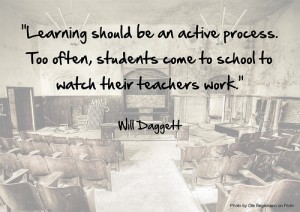Tell me and I forget. Teach me and I remember. Involve me and I learn. – Benjamin Franklin
The blog area on the Blackboard site of various courses is rarely used for teaching and learning. The blog has a great potential to initiate discussion, exchange knowledge and information in a fun way, communicate one’s views and opinions, network, and build relationships. Even if a university is not using Blackboard, the Professor can still have a blog on the course website.
For a Marketing class, we can design a blog-related exercise which not only encourages students to interact with one another but also triggers a thought process which would facilitate discussion in class. A sample exercise would be:
Before the class on branding, the professor would assign a task to the students which would involve sharing a brand logo story (short paragraph or 6-10 sentences) on the blog. This story could be about a brand success or a brand failure.
An example of a successful brand would be NIKE – “The company takes its name from the Greek goddess of victory, Nike. The Nike “Swoosh” is a design created in 1971 by Carolyn Davidson, a graphic design student at Portland State University. She met Phil Knight while he was teaching accounting classes and she started doing some freelance work for his company, Blue Ribbon Sports (BRS). BRS needed a new brand for a new line of athletic footwear it was preparing to introduce in 1972. Knight approached Davidson for design ideas, and she agreed to provide them, charging a rate of $2 per hour. The logo represents the wing of the Greek Goddess. The “JUST DO IT” slogan and logo design campaign communicated such a strong point of view to their target market that the meaning for the logo design symbol evolved into a battle cry and the way of life for an entire generation. Isn’t it amazing how a small symbol we call a logo design can make a company into a huge success”.
Every student who submits a story before the deadline (3 days before the class), would get 5 points. On the day of class, there would be a quiz (worth 5 points) about the shared stories. These stories would then be linked with the lecturing material for that day’s class as real-life examples of how brands are created, how they evolve and how the brand value is enhanced. The brand failure examples would help understand “what not to do” in branding.
Another exercise for a marketing class that involves blogging would be initiating discussion on a topic involving the readings for the next class. For example, if the next class topic is “Culture and Marketing”, there would be a few issues posted by the instructor on the blog, which would trigger the discussion.
Some examples would be:
- One of the most famous examples of cultural blunders in marketing is Coca Cola translating the name into Chinese without back-translating it. The translation conveyed the meaning -“bite the wax tadpole”. Ultimately this resulted in a horrible response from the Chinese who felt insulted. Do you know of other such blunders in real-world marketing?
- Why is “Think Global and Act Local” an important international marketing mantra? What kind of companies need to follow this mantra in their international marketing efforts?
The students are expected to participate in this blog discussion by posting their views and their learning from the readings. The participation cannot be in the form – “I agree with what Donna said”. There should be something different from already posted views and there should be reasoning for everything they post on the blog. The deadline for participation would be 2 days before the class. The students who participate in the discussion would get 5 points for their comments and reasoning. These discussions would then be linked in the classroom instruction for “Culture and Marketing”. The blog posts would have already triggered a thought process in the minds of the students which would enable them to actively participate in classroom discussions also.
Thus, these exercises will make sure that students use the blog technology to their advantage, engage in active learning, and also enhance their learning with real-world examples. Also important to note is that students would not repeat or duplicate the examples because they can read the earlier posts to make sure that they do not post the same information or example.
The misuse of the blog would lead to penalty points of negative 20. This would ensure that students use the blog for learning purposes and not for any kind of anti-social activity or playing around. In a nutshell, blogs are a great teaching and learning technology if used in the right way.



Leave a Reply